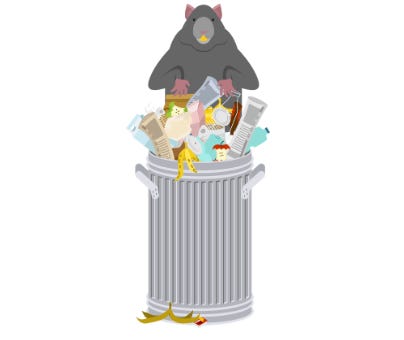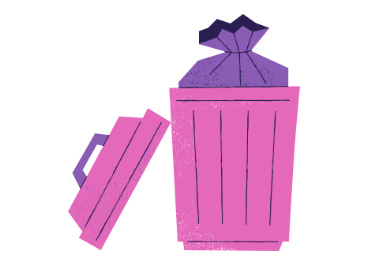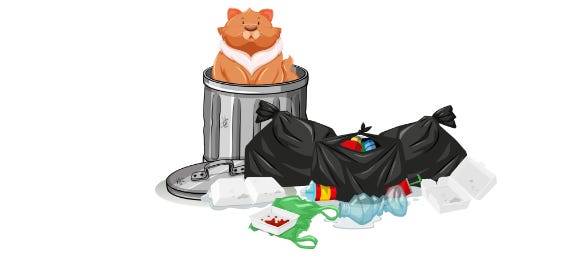Something adorable: Garbage runs in my family.
My older brother, Nick, is the founder of flipmacs, a company that……
Well, I didn’t really know. Whenever people ask me what my brother does for work, I usually say something about refurbishing computers and carry on with my life. Not long ago, Nick texted me a selfie where he was posing ruggedly in front of a huge heap of trash and I thought to myself, wow.
I’m not sure that this is a typical sibling selfie — for us it’s pretty standard. But for once, I decided to dig a little deeper.
Nick is, in part, in the business of e-waste (electronic waste). Wut, you ask? Think about all of the broken iPhone charging cords you’ve either thrown in the garbage or bundled in a junk drawer. Or, think a little bigger, and recall the now-ancient laptop you used at work 10 years ago.
What happens to this stuff? An estimated 50 million tons of e-waste is generated every year, with only about 20% getting recycled. In addition to the standard consequences of shit being offloaded into landfills — think methane release, increased risk to human health, blah blah blah — e-waste poses an even greater threat to our livelihood. Most e-waste contains toxic materials like flame retardants, lead and nickel. When these materials get heated up (in landfills), these toxins are released into the atmosphere. They also also seep into the groundwater. It’s not good.
Nick and his company prevent a lot of this chaos by finding new purposes for materials (you know what they say about one man’s trash…), reviving hardware that still has life and beyond. He graciously agreed to a little interview and I learned so much about the process and how he fell into this world (it all started with a teenage boy, a broken iPod and a dream).
I hope, even if you aren’t our parents, you’ll find our conversation as interesting and educating as I did.
Kate: How did you come to collect 4,000 pounds of metal?
Nick: Our company serves some local businesses and we do outreach to people who are looking to get rid of their old tech. What we do is literally de-commission old equipment — meaning we unplug it, we remove it, we haul it and we sort it out into different materials and then we bring it to one place or another, or sometimes reuse it.
The goal is to reuse before we end up scrapping the material.
Why would a company reach out to you to get rid of their technology? Wouldn’t it be easier to toss it in the garbage?
It would be easier to toss it in the garbage but the major concern these days is data. People don’t feel comfortable just throwing their devices out because there could be precious or sensitive intellectual property on these drives.
Most people aren’t versed in removing individual components from their computers — like a hard drive or something else. So they go to companies like us who not only take the equipment out but we also erase their data and provide them with whats called a certificate of data destruction. That certificate gives them peace of mind that their data was wiped in a way. It’s a universally accepted way of wiping data that’s so secure that the person who wiped it doesn’t even know what’s on it.
Do people pay you to take their items off their hands or do you pay them?
Both. Depends on what the equipment is. If it’s very old equipment that isn’t gonna have a next life — especially if there’s going to be data erasure involved in it — that’s a situation where we’ll charge the customer. If there’s hazardous material like lithium ion, that would be another charge.
But the hope is that we can either pick the product up for free and not have to charge the customer because there might be some value in the resale of that product, or we can actually buy that equipment and couple in our service cost for the pickup and the wiping into the cost of the goods.
What kind of items contain lithium ion?
Mostly laptops and portable items like phones. Lithium ion seems to be a pretty good solution for keeping batteries good for longer than they used to. The issue is toxic chemicals that are bad for your health and the environment — we have to be careful when we remove the stuff and make sure we get it to a place that’s going to care for it in a way where it won’t end up in a landfill or even worse.
The process is to let the batteries run out completely before we start to work on them. It lessens the chance of a thermal event occurring — meaning you’re not going to have any sparks, fire or create some sort of chemical reaction that could be bad for your health or hurt you.
Then we drop them off to a center that breaks them down into individual parts.
How the fook did you learn about this?
By accident. I kind of fell into it. When I was 13 I broke my iPod and I started to buy up all of these iPods and fix them and sell them in school and started my own little eBay business.
I cracked it open with a Swiss army knife and I was like, oh I think I could fix this. They were really easy to work on so I started to buy them up broken and cobble together different parts from used ones or broken ones and create these Frankensteins.
Then it went further and I got really obsessed with laptops. I kind of kept it going in college, I wasn’t really doing any of the refurb or repair but I was doing some of the flipping — doing a lot of Craig’s List buying and then resell. I made a couple of extra bucks in college doing that and then I kind of got addicted to the laptops, the MacBooks, especially the model number a1181, which were the white MacBooks everyone had — it was the most popular model when I graduated.
I had like a stack of 40 of them and I’d take each one apart and try to make the best out of however many there were. I started to talk to people who were actual members of the industry and started to work out a real bulk wholesale business where we can bring in loads of hundreds of devices at a time, which we do multiple times a week, and process them with a team in the right way and be able to allocate whats good and what’s not.
Over 99% of the stuff we bring in doesn’t end up in a landfill — I’m talking everything from the plastic speakers inside the computers to each individual screw. The amount of stuff we’re able to salvage is pretty tremendous.
Not every computer we sell looks brand new but every single one of them is at least on it’s second life. It’s interesting to see the lifecycle of these devices and know that a lot of the stuff that people get rid of is still good and might not even need much of an update or any update at all to live on in someone else’s hands.
There’s so many different use cases for stuff and we figure out a way to use so much. The battery is really the biggest issue — that’s the wear item, as far as these portable devices go. The battery is really the most wasteful item. We recycle around 300 batteries a month. Not every device gets a new battery — some come in that can still live for a couple more years without needing replacement
Staples sometimes advertises that they do electronics recycling, I think home depot does it, there’s a lot of big box stores that’ll take your old batteries and old devices.
What should people do with their old broken tech stuff instead of throwing them away?
A lot of community transfer stations will be able to recycle that stuff. [People] can recycle at Staples and other national retailers, or they can donate or sell the items locally through Facebook marketplace or similar.
P.S. If you have some wires, chargers and e-junk to recycle, you can take them to Staples, BestBuy or search for an e-waste recycler near you. Click the button below to get started. Love you!









Always knew Nick would be a Super Hero! Kate, thanks for what you do to make us laugh and cry-but try to do better! Full disclosure-Nick is my godson.
I am not your parent, and I thoroughly enjoyed this. So cool that garbage runs in the family! (Also, that is too many unread texts.)